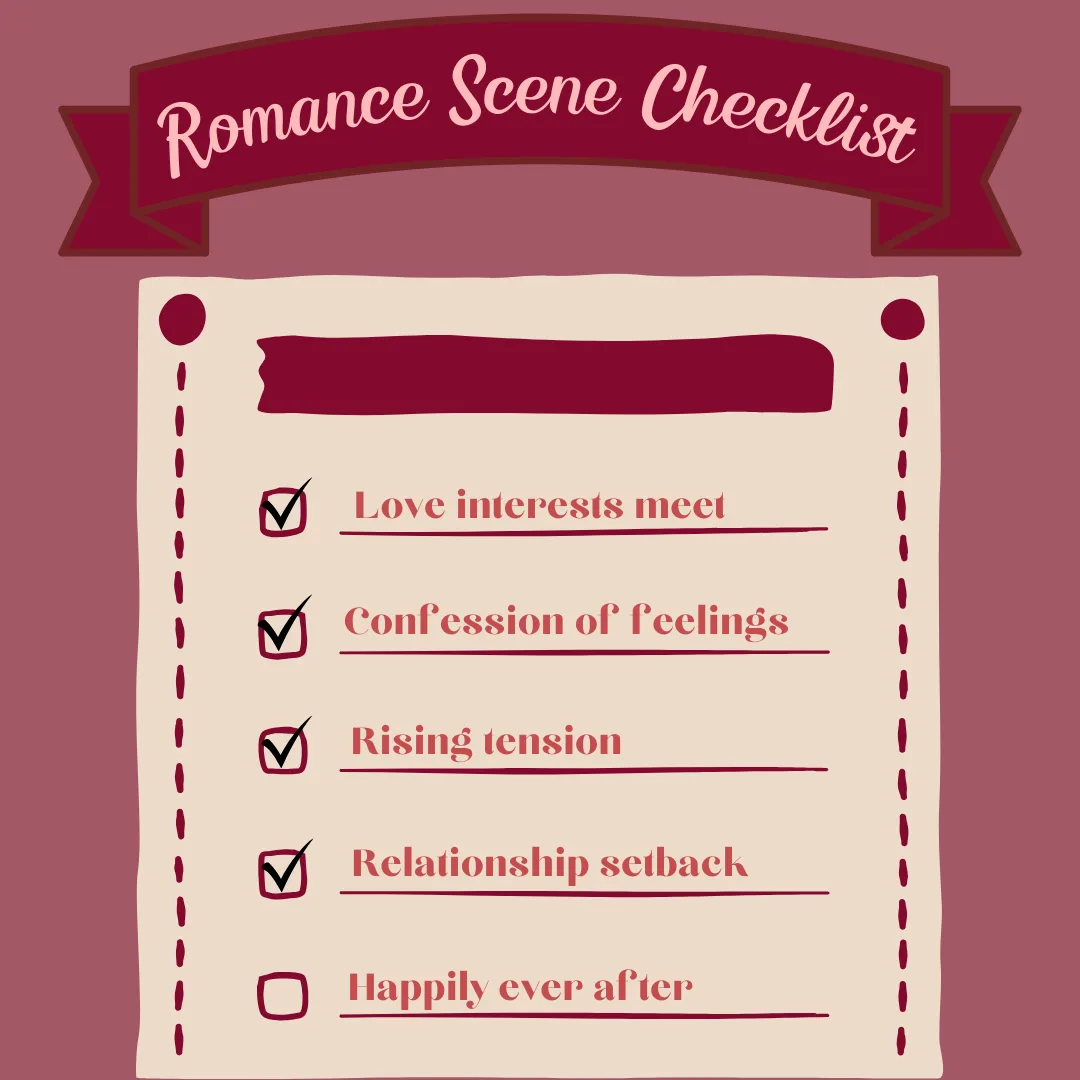Romance Novel Template | Scene-by-Scene Plan
Sage Kay
Writer, reader, outfit repeater.
The romance genre is one many keep coming back to because of its reliability in narrative arcs, character archetypes, and happy endings. In other words, there are specific story beats and types of scenes you should include in every romance genre story, so it's important to understand what makes a romance novel before you sit down to write one.
The romance genre is unlike others because it follows a formula that all romance readers will expect when they pick up your amorous account of a budding relationship between two unsuspecting main characters. Sure, every genre includes specific story elements that make it worthy of the genre it begs to be a part of, but the romance genre—or more accurately, the romance readers—expect you to hit a few specific elements. So, study up because your readers are counting on you!

Important Elements of a Romance Novel
There are several key factors you should include to make your novel a classic romance genre piece.
1. Love interests meeting
As obvious as this is, your love interests should meet in a unique (and maybe $ embarrassingly adorable$ ) way that sets up the nature of their relationship. How your characters react to their first meeting will say a lot about the characters themselves and what the nature of their relationship will be going forward. If it’s your classic meet-cute, your characters might be flustered or even a little frustrated, perfectly setting up that annoyed-strangers-to-lovers arc. If they’re old flames running into each other by chance, there will be a lot of complicated feelings from both parties that will undoubtedly lead to a rekindling. Make it as cute or as disastrous as you’d like, but consider what this interaction will say about your characters and what problems it may set up for the future.
2. Setting and how it affects your love interests
A romance story isn’t a romance story without a quirky setup that forces your love interests to interact. In Red, White, & Royal Blue, it’s the two boys’ respective political lives. In The Fault in Our Stars, it’s the cancer support group that neither character is particularly excited about participating in. Your setting should not only be interesting but play a role in the budding romance and ultimately be the reason your characters continue to find themselves in each other’s company.
3. Relationship setback
As sad as your readers will be, there needs to be conflict in your the relationship to keep the plot moving. Now, this can take the form of whatever you’d like—the lovers being forced apart by something out of their control, an argument where insults cut a little too deep, or a character’s personal issues getting in the way of their own happiness—but there should come a moment where your main characters evaluate whether their relationship is worth fighting for. Which leads me to my next point, an absolute must in the genre:
4. A happy ending
Romance fans love the escapism and reliability of a happy ending. While there are subgenres/sister genres of the romance novel that can end tragically, if you will market your book as a classic romance, a happy ending is required. Anything else results in your romance splitting off into a subgenre, like a romantic tragedy, and your marketing for the book should reflect that or else you’ll end up with some unsatisfied readers. If you’re John Green or Nicholas Sparks, feel free to crumble up your reader’s hearts and throw them into a fire, but be sure to clean up the ashes and put them in a nice urn before your reader gets to the last page.
Romance Scene List Template
Now that you know what elements to include in your romance novel, let’s discuss what specific scenes should get a spot in your outline.

Scene-by-Scene Romance Novel Outline
If we're getting down into the so-specific checklists of a romance novel, here are the scenes you should write. A few things to keep in mind before we get started:
1) Some items on this list may need multiple scenes to complete.
2) If you have multiple POV characters, you'll likely have mirrored scenes of these (e.g., we should see The Normal for each romantic interest).
3) You can add scenes between these beats. Get creative if you'd like to! You can use this list as the baseline for your novel outline.
Okay, let's get into some specific romance novel scenes.
1. The Normal
We see the MC's normal world before they meet the love interest(s). This scene establishes things like the setting, the time period, their living situation, a hint at their inner demons, friends and/or family, what they do for work, and maybe a few other little personal details. We should get a "Normal" scene for each POV character to set up their lives before the inciting incident.
2. The Meet-Cute
The lovers should meet early in a romance novel, so let's put this scene right after we've established the world and characters. A meet-cute can be replaced with a disaster, misunderstanding, or any other type of situation you'd like to inflict upon them. $ Read more about writing meet-cutes$ .
3. Rejected!
One or both (or all) of your main characters might have some negative reaction to the other. Maybe it's a misunderstanding, maybe their humor clashes, maybe there's an outside circumstance that puts them at odds. This can be a mutual feeling, or a more dynamic situation, like one character being madly in love while the other thinks they're such a dweeb.
4. Sidekicks
Every good romance has the Best Friend for our character(s) to rant, vent, and discuss their romantic interest. The friend is usually supportive of the relationship, encouraging their friend in a pursuit. Every POV romantic character should have a friend or mentor to voice their thoughts to.
5. Admission of Guilt (found guilty of HAVING A CRUSH HAHA, loser)
When we have a reluctant MC in a romance novel, there has to be a scene where they finally break and admit their attraction. Again, this could happen for each character, or only one.
6. Romance
While our story should have conflict and complications, it's important to have the Having Fun Montages throughout to show our lovers growing closer.
7. First Hiccup
A disagreement or argument throws a wrench in the romance, making one or all of the lovers pause. Is this the right decision? Are they a good match? Seems sus rn!
8. Rinse and Repeat
Here at the midway point, we get our lovers moving toward and apart from each other, making up, breaking up, hashing it out with their sidekicks, working through their own subplots next to the romantic plot. This is the meat of the story.
9. The False Defeat
Love is a lie. It's clear that this relationship was never meant to be! Here you can include some sort of crisis (one character's ex returns and wants another chance), a misunderstanding, or a clash of opinions/values. Things look bleak, and we just don't know if we can move forward.
10. Alexa, play Reunited by Peaches & Herb
We CAN move forward after all! Our characters accept that they are meant for each other, despite the internal and/or external struggles keeping them apart.
11. But Life Is Hard!
Work up the tension even more here, building up to our story's climax. How are the subplots going to crash together and tie the story up into one good action point?
12. Climax 😏
And the big deal scene. How has this mounting (lol) tension exploded? The couple should work together to overcome their internal issues and the fallout of the plot. In the end, they come together (lol) and save the day.
13. And They All Lived Happily Ever After
Like we've been saying, the happily ever after is required for a romance novel!
14. Epilogue
While this is optional, many romance readers expect an epilogue. "Married with a baby on the way" is a common trope here, but of course this is open to interpretation. Show your characters happy and let the readers know the general direction they're headed in.
Now that you have all the tools you need to write your romance story, give it a shot! Need some help? Check out $ the best tools for romance authors$ .
Like what you're reading?
Join other authors like you in NovelPad’s free writing community!
Join the communitySimilar Posts
What File Formats are Accepted by Kindle Direct Publishing?
File types for ebooks, paperbacks, and hardbacks on Amazon's KDP.
Ollie Ander
Is probably just a couple cats in a trench-coat—the hair shedding and sunlight napping are highly suspect.
When is the best time to publish a horror novel? [Peak Sales Method]
Make the most of your horror book launch by strategizing with these tips.
Bella Rose Emmorey
book editor, rogue behaviorist, digital marketer, writer, brand builder, plant aunt, and cheese enthusiast.
How to Publish on Kindle Unlimited | A Comprehensive Step-by-Step Guide
Everything you need to know about enrolling your book on Amazon's Kindle Unlimited.
Ollie Ander
Is probably just a couple cats in a trench-coat—the hair shedding and sunlight napping are highly suspect.
Do Self-Published Authors Make More Money?
Royalty rates, merchandise sales, ad control, and other ways self-published authors stand to make more money.
Bella Rose Emmorey
book editor, rogue behaviorist, digital marketer, writer, brand builder, plant aunt, and cheese enthusiast.
How To Write Strong Atmosphere In Stories
7 best tips for creating strong atmosphere in your writing.
Hannah Lee Kidder
NovelPad Author
What is Write-to-Market? An Author's Fast-Track to Earnings
Writing to market is one of the most successful sale strategies for self-published authors. Here's how.
Bella Rose Emmorey
book editor, rogue behaviorist, digital marketer, writer, brand builder, plant aunt, and cheese enthusiast.